Season 2 of Shudder’s Cursed Films is set to air on April 07, 2022, with the first season focusing on the horror stories behind the filming of the cinematic masterpiece, ‘The Wizard of Oz.’
We, at Horror Facts, couldn’t wait for the episode to air, so we thought we would give you a look into the events that transpired while making ‘The Wizard of Oz’ ahead of the episode’s premiere.
I’m sure that the idea that this classic piece of cinema history could be “cursed” might seem like a confusing premise, especially since the film, although featuring a witch, has nothing to do with the horror genre.
But you’ll be surprised to learn that many of the actors had to endure hellish conditions on set and some were even involved in potentially life-threatening accidents.
We also look at the long-standing rumor of the “hanging munchkin.”
So, join us as we go somewhere over the rainbow and discover that, in their mission to find the wonderful wizard, our actors first had to survive the land of Oz.
The Tin Man is Hospitalized
It may surprise you to know that Jack Haley was not the original actor cast in the role of the Tin Man in ‘The Wizard of Oz.’ The role was originally given to Buddy Ebsen.

Ebsen would, unfortunately, end up becoming hospitalized weeks after being cast as the Tin Man as a direct result of the powdered aluminum dust that the makeup department had been blowing onto his face for the past two weeks.
To give off the look that Ebsen was made of tin, the studio had been using powdered aluminum, thinking at the time that, because the dust was “pure aluminum,” it wouldn’t have any repercussions on his health. At the time, it was common practice to expose miners to pure aluminum dust, thinking that it helped to prevent the miners from developing silicosis (a form of lung disease associated with mining).
In reality, the pure aluminum coated Ebsen’s lungs, resulting in the actor finding it difficult to even breathe. Ebsen stated that, “One night, after dinner, I took a breath and nothing happened.”
He was rushed to the hospital, where he would remain for the next two weeks. Some reports claimed that Ebsen had to be placed in an “oxygen tent” while others have stated that he went so far as to be placed in an “iron lung” during his hospital stay. Either way, Ebsen’s lungs had been severely damaged from the exposure to the Tin Man makeup.
While he was in the hospital, executives from MGM kept calling, demanding that Ebsen return to set.
According to Ebsen, “It seemed they couldn’t understand that an actor could get sick. They were furious.”
He specifically named Mervyn LeRoy, who served as an uncredited director on ‘The Wizard of Oz,’ stating that LeRoy “kept calling the hospital and saying, ‘He can’t be in bed. He’s due on set.’”
Angered by Ebsen’s inability to return to set, the studio executives eventually fired him and hired Jack Haley to replace him. At the time, Haley was under contract with 20th Century Fox, who agreed to loan him out to MGM, meaning that Haley never auditioned for the role but, rather, was told that he would be portraying the Tin Man; he had no say in the matter.
Haley described his casting in the ‘Wizard of Oz’ in the following way: “The type of contract I had, I had to respond to their commands. I had no choice. I was under contract, and they could lend me to any studio. It was the most awful work, the most horrendous job in the world with those cumbersome uniforms and hours of makeup, but I had no choice.”
With Haley, they changed the way they applied makeup to his face. Still determined to use the powdered aluminum, this time it was not brushed on like a powder but was made into a paste and painted on.

Even this new method wasn’t without incident. At one point in the film, Haley ended up suffering a severe infection in his right eye from the aluminum paste that almost resulted in permanent damage to his sight.
The Makeup Nightmare Continues

Along with the eye infection, Haley also stated that, with the makeup on, he “couldn’t breathe” through his face.
Ray Bolger, who portrayed the Scarecrow in ‘The Wizard of Oz’, identified that he suffered the same issue with his makeup.
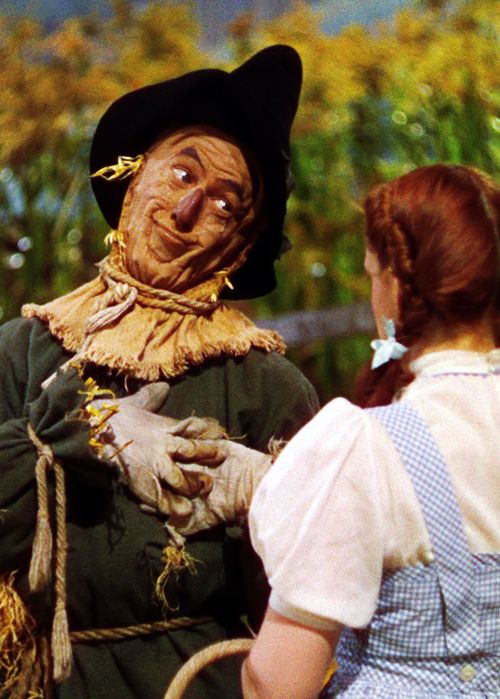
Bolger wore a foam rubber mask that was baked in an oven, resulting in something that resembled a rubber bag. The bag was then placed over his entire head except for his eyes, nose, and mouth. The bag extended down to his neck where it was tied with a piece of rope.
Bolger is quoted as stating, “The mask wasn’t porous so you couldn’t sweat. You couldn’t breathe through your skin. You don’t realize how much you breathe through your skin until you can’t do it. We felt like we were suffocating.”
Despite both their issues, Haley would state that, “Bert Lahr had it worst of all.”
It’s Getting Hot in Here
The Cowardly Lion costume Bert Lahr wore was made out of real lion hair. The suit was also padded. It was described as “carrying around a mattress with you” and said to weigh around “70 pounds.” At the end of the day, he would be dripping wet from sweat. It would have to be dried out every night, as they only had one costume. Along with the suit, Lahr wore an enormous fur wig on his head and his chin was covered in a fur beard.
Lahr would also not escape the dreaded makeup chair. A prosthetic lion’s mouth and nose were glued to his face. They made it so the actor could not open his own mouth wide enough to chew. Filming on ‘The Wizard of Oz’ could sometimes last as long as fourteen hours. The entire time, Lahr could only eat whatever he could drink through a straw.
Makeup artist Charlie Schram is quoted as stating that Lahr “went through hell.”
The Hellish Conditions On Set
The reason each actor suffered from the heat was because ‘The Wizard of Oz’ was filmed in three-strip Technicolor. While it might not seem like a film in color is a big deal today, at the time it was still relatively new technology.
(It’s a common misconception that ‘The Wizard of Oz’ was the first movie filmed in color. This is not true.)
In order to highlight the vibrant colors on screen, the studio had to use huge arc lights to light the large sets. This made the set “brutally hot.” It’s reported that people would regularly faint due to the heat and would then have to be carried off set.
When the temperature become unbearable, Victor Fleming, the director, would open the stage doors.
The primary cast of the film would take advantage of these moments and rush toward the doors, where they would stand outside gasping for breath until the set cooled off enough for them to resume shooting.
This paints a picture of the hellish conditions each actor must have suffered in full costume, and one can hardly begin to imagine the temperatures that Lahr had to endure.
The Wicked Witch is Set on Fire
The scene in ‘The Wizard of Oz’ where Dorothy first encounters the Wicked Witch of the West is a piece of cinematic history.
After Dorothy’s house lands on top of her sister, the Good Witch Glenda places the witch’s ruby slippers onto Dorothy’s feet. Angered by what has transpired, the Wicked Witch of the West utters her iconic threat of, “I’ll get, you my pretty, and your little dog, too,” before disappearing in a cloud of smoke and fire.

To achieve the appearance that the witch was able to magically vanish in the blaze, Margaret Hamilton had to step onto a secret elevator that would lower as the large cloud of smoke and fire erupted around her.
There were problems with the effect right from the start. The pit the elevator lowered into was extremely narrow at the top. There was just enough room for Hamilton to fit through. She had to take special caution to pull her arms in close to her while going down, as one snag would have certainly resulted in Hamilton breaking an arm.
The first take went off like “clockwork.”
Fleming was, however, a perfectionist and called for the scene to be shot again. In their second attempt, the smoke and fire started too late to disguise Hamilton’s disappearance. In the third attempt, the smoke started too early and the fire didn’t come at all.
On the fourth attempt, the smoke and flames came quickly – too quickly – resulting in the bristles on Hamilton’s broom catching on fire. Because Hamilton had to bring her arms in so close to her body, the bristles of the broom were directly in front of her face. This resulted in Hamilton “scalding her chin, the bridge of her nose, her right cheek, and the right side of her forehead. The eyelashes and eyebrow on her right eye had been burned off; her upper lip and eyelid were badly burned.”
Along with her face, Hamilton also received severe burns to the hand she had been using to hold onto the broom at the time. Her injuries were described in the following way: “From the wrist to the fingernails on her right hand, there was no skin. It was as though someone had taken the top of her hand and peeled it like an orange.”
If you think suffering second and third-degree burns to her face and hand weren’t painful enough, what came next was surely agony.
As the witch, Hamilton was required to have her hands and face painted green. The trouble was that copper oxide was used in the development of the paint during that time. As a result, if left on the skin, it would be toxic to the wearer.
At the end of every day, Hamilton would have to undergo a thorough cleaning to ensure that none of the paint was left on her skin.
This day was no different. Before Hamilton’s wounds could be treated, the poisonous makeup had to be removed. The usual techniques to remove the makeup could not be applied at the time. Instead, they had to pour alcohol onto the recently burned skin of Margaret Hamilton to ensure the remaining green makeup had been removed.
During the entire process, Hamilton did not scream.
Then it was time to add insult to injury.
The following day, Hamilton received a call from the studio wanting to know when she would be returning. It had been roughly only 24 hours since the incident occurred.
Hamilton ended up staying away for six weeks before returning to set.
She would end up having to wear a green glove on her right hand, as only a light layer of skin had grown back. It was also said that the nerves in her hand were still exposed.
A Stunt Performer Almost Loses a Leg
Shortly after returning to the set of ‘The Wizard of Oz’, Hamilton was told that she would be performing the skywriting scene. In the scene, smoke billows out of the end of the broom while the Wicked Witch writes “Surender Dorothy” in the sky.
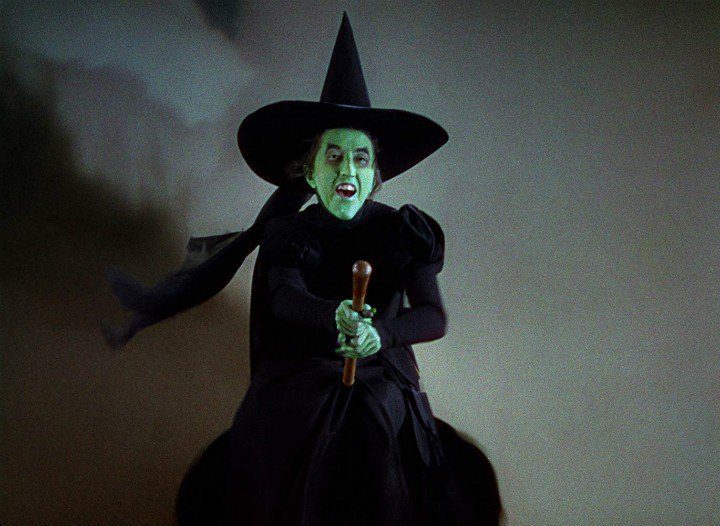
The stunt called for Hamilton to sit on a steel saddle that was attached to the broomstick. The broomstick would then be raised ten or fifteen feet into the air where it would be suspended from the top of the stage by four wires.
The saddle had a pipe underneath it where the smoke would pour out to simulate the skywriting.
As if expecting that the stunt wasn’t entirely safe, they had designed a fireproof costume for Hamilton to wear. Having just suffered severe burns to her face and hand, she refused to perform the stunt.
She ended up agreeing to sit on the broom, minus the steel saddle, and be raised into the air to get the close-up shots needed for the scene.
Stunt performer Betty Danko agreed to provide the wide shots of the witch riding the broom.
The first time they performed the stunt, everything worked perfectly. It appeared as if this stunt would go off without a hitch. That is, until Fleming arrived on set.
For the first two takes, the witch’s cape was pinned down to conceal the pipe sticking out from the saddle. Fleming, however, wasn’t keen on this idea and wanted the cape to blow in the wind that was emanating from the on-set wind machines.
In order to achieve this, the pipe would need to be remounted. This time it would be directly under where Danko was sitting.
The first two times Danko pressed the button to release the smoke, it worked as intended. On the third press, the pipe exploded.
The explosion blew Danko off the broomstick which was suspended fifteen feet in the air.
Having a survival instinct, she managed to grab the broom with both hands and throw one of her legs over it. She hung there while the men on the ground frantically lowered the broom back down to the stage.
Danko’s left leg was bruised from thigh to knee and she had an inch-deep wound that nearly circled the leg. The wound was said to be filled with bits of her costume.
To this incident, too, let’s add some insult to injury.
While Danko lay face down on the stage waiting for the ambulance to arrive, an unidentified woman from the wardrobe department began screaming at her. Her issue? The witch’s hat that Danko had been wearing was nowhere to be found. It’s rumored that she uttered the following phrase to Danko:
“What did you do with the hat? I have to turn it in you know.”
A couple of days later, they ended up finding the hat on top of the stage. This explains why, when asked about the whole ordeal, Danko replied, “I felt as though my scalp was coming off.”
In total, Danko would spend eleven days in the hospital before being discharged.
While there, she learned that two of the actors that played the winged monkeys had also recently been patients there. They had been admitted to the hospital after the wires used to suspend them had broken.
Danko ended up receiving a payday of $35.00 for performing the stunt.
Judy Garland Can’t Stop Laughing
In the scene where we’re first introduced to the Cowardly Lion, he puts on false bravado that ends with him chasing Toto.
This scene then called for Garland to slap Lahr, who played the Cowardly Lion, and proceed to scold him for his actions. On-screen, the lion would continue to bawl as he received a verbal tongue lashing from Dorothy.
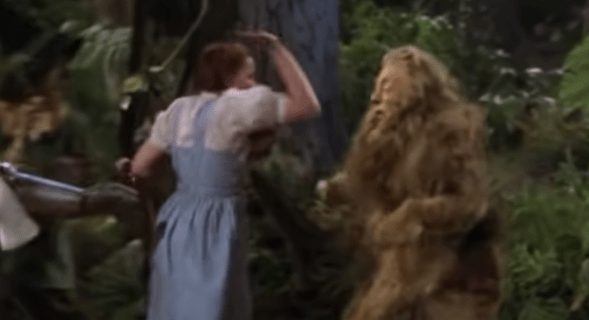
The issue was that Garland had trouble staying focused, as she found Lahr’s performance to be quite funny. This resulted in Garland being unable to keep a straight face while berating her co-star. Numerous times, she would burst out into laughter.
After a couple of takes, she attempted to regain her composure by going around a tree and audibly repeating to herself “I will not laugh.”
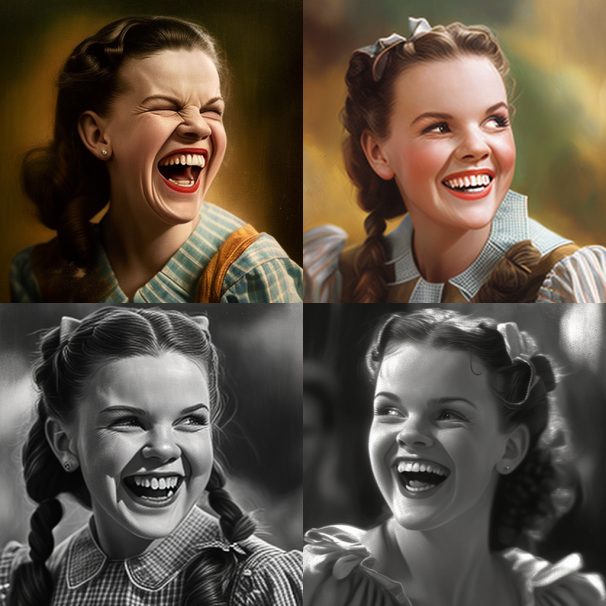
At first, Fleming appeared to be patient with the young star, but then she would come out and laugh again.
In total, the scene was performed ten times and, by this point, Garland had driven herself into a frenzy, making herself hysterical with laughter.
In response to her actions, Fleming then grabbed the young Garland and proceeded to slap her across the face.
Garland then performed the scene without breaking character. This take is the one that was used in the film.
Let it Snow
In the scene where Dorothy and the Cowardly Lion fall victim to the Wicked Witch of the West’s sleeping spell, Glinda the Good Witch uses her magic to awaken the sleeping pair in the poppy field by causing it to start snowing.
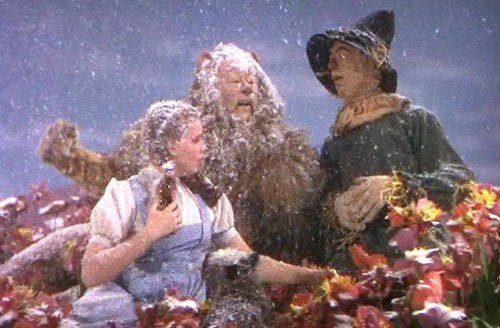
The snow that the studio dumped on their actors, however, was reported to be ground up asbestos. At the time, the dangers of asbestos were still unknown.
First, they blew aluminum dust in their actor’s face and next they dumped a carcinogenic substance on them.
The Rumor of the “Hanging Munchkin.”
The rumor is that one of the actors who played a munchkin in ‘The Wizard of Oz’ committed suicide by hanging himself from one of the trees in the background following the introduction of the Tin Man.
Supposedly, as Dorothy, the Scarecrow, and the Tin Man are strolling down the Yellow Brick Road while belting out the memorable tune of “We’re Off to See the Wizard,” you can see the body of the actor, who, as the legend goes, took his own life after he was rejected by one of the female munchkins.
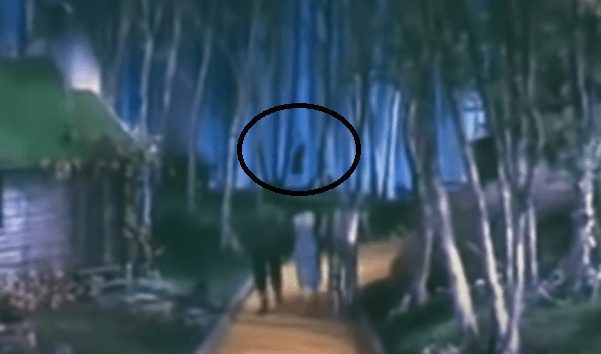
The reason for this myth is, if one were to go back and watch one of the earlier copies of the film that predate the film’s 50th-anniversary rerelease in 1989, there is an indistinguishable, shadowy figure between the trees.
This unknown figure soon became the object of speculation, and out of that came the urban legend of the “Hanging Munchkin.”

In reality, several birds were borrowed from the Los Angeles Zoo to make it seem like the film was shot in a forest. The figure in the woods is one of the large birds borrowed from the zoo.
Following the 50th anniversary release of the film, the footage was cleaned up and the large bird (some claim it’s either an emu or a crane) can be seen expanding its wings right as the trio passes it. It’s noticeable in the shot that the bird has a large, white wing tipped with black feathers.

One would think this would squash the rumors but, in reality, the rumor of the “Hanging Munchkin” only surfaced after this restored version of the film was released, with many claiming that MGM added the bird to cover up the hanging.
One would have to wonder how MGM executives would have allowed the footage to make it into the final film in the first place. It’s unlikely that, if someone had hung themselves in the woods, they would have carelessly overlooked this fact and were willing to place the footage into the movie.
This has spawned other rumors that the image was a stagehand who mistakenly got caught on camera. It still happens to this day; crew members accidentally make their way into the frame.
The re-release was then MGM’s way of editing out the careless crew member and replacing him with the bird.
No matter the fact that the legend of the “Hanging Munchkin” has been debunked, it seems unlikely that this rumor will ever be put to rest, as many still refuse to believe that the grainy image in the original 1939 film is anything but a depressed actor who decided to take his own life on the set of ‘The Wizard of Oz.’
The Munchkins Were Rumored to Have Wild Parties
Another story involving the munchkins paints a terrible picture of their demeanor both on and off the set.
While filming the movie, the actors portraying the munchkins stayed at the Culver City Hotel, a shabby hotel about a mile from the studio.
Noel Langley, who served as one of the many screenwriters of ‘The Wizard of Oz,’ described the actors as “very raunchy people” and alleged that they would get into “sex orgies at the hotel.” He added that the police had to be stationed on “every floor” due to their antics.
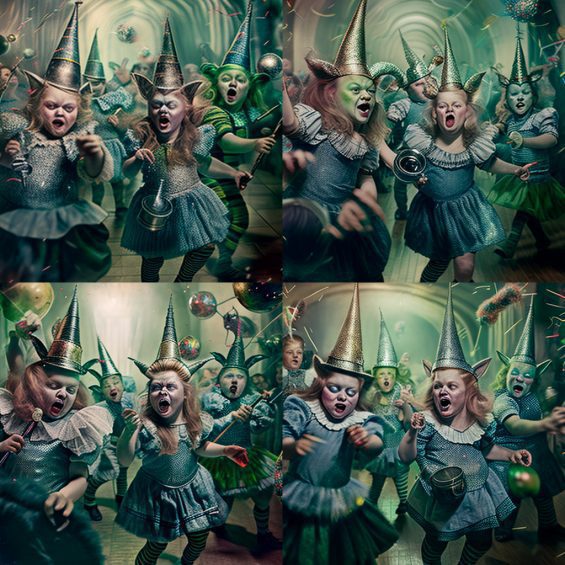
During an interview with Jack Paar in 1967, Garland claimed that the actors were “drunks that got smashed every night” and that the police “had to pick them up in butterfly nets.”
Garland would also claim that “they raided the lot” and that the “showgirls had to be escorted in bunches by armed guards” due to their depravity.
In a posthumously published memoir by Judy Garland’s third husband, Sid Luft, he claimed that the actors who played the munchkins “would make Judy’s life miserable by putting their hands under her dress.” This story was never confirmed.
It should be noted that none of these claims was made during the filming of the movie. They only came about many years later, with Garland being the main source of the allegations. It should also be noted that around the same time, Garland also spoke ill of her three castmates, claiming that they attempted to “out stage” her every chance they got. So, one has to wonder just how much truth there is in Garland’s words.

These are just a few of the stories and accidents that befell the cast and crew of ‘The Wizard of Oz’ while making the film.
There have been other rumors associated with the film, including that the studio forced Garland to maintain a diet of strictly chicken soup and black coffee and that they forced her to smoke around “50” cigarettes a day, some have even claimed upwards to “80.”
This proves that Oz wasn’t such a magical place after all, and that maybe Dorothy had the right idea after all: “There’s no place like home.”
Season 2 of Shudder’s Cursed Films, featuring ‘The Wizard of Oz,’ aired on April 7, 2022.
Check out more haunted, cursed and horror movie facts in our Horror Facts Database of Facts.

